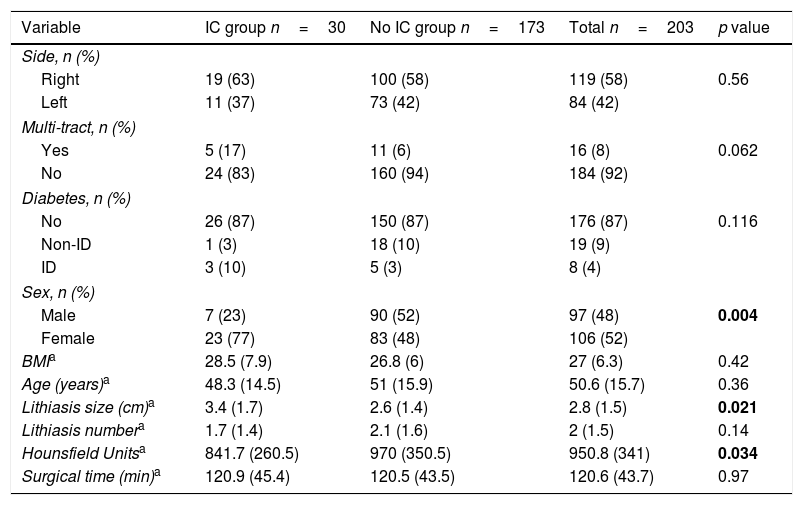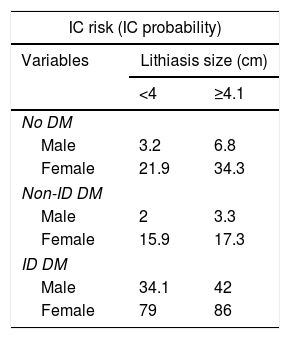Infectious complications (IC) following percutaneous nephrolithotomy surgery (PCNL) can be life-threatening. Our objective was to analyze preoperative predictors of IC in PCNL.
Materials and methodsA total of 203 patients who underwent PCNL were included in a prospective study between January 2013 and February 2016. A postoperative IC was defined as urinary infection/pyelonephritis, systemic inflammatory response syndrome or sepsis. The variables analyzed were age, gender, number, size (cm) and side of stone; Hounsfield units, diabetes (insulin dependent or not), preoperative culture, isolated bacteria, multitract, body mass index and surgical time (min). A multivariate forward stepwise (logistic regression) was performed.
ResultsIC occurred in 30 patients (14.8%): 9 (4.4%) had urinary infection, 14 (6.9%) systemic inflammatory response syndrome and 7 (3.5%) sepsis. In addition, 13 (43.3%) had negative preoperative urine culture, 15 (50%) positive and in 2 (6.7%) was not available. On the logistic regression analysis, stone size (cm), insulin dependent diabetes and female sex were independently associated with increased risk of IC (odds ratio [OR] 1.03, 14.6 and 7.8, respectively; p=0.0001).
ConclusionsPatients with large stone burdens, insulin–dependentdiabetes condition and female gender, should be counselled properly regarding postoperative infection risks and closely followed up to diagnose IC (specially sepsis) soon enough. Negative preoperative urine culture seems not reliable enough to exclude an infectious complication according to our results.
Las complicaciones infecciosas (CI) tras la nefrolitotomía percutánea (NLPC) pueden llegar a ser de gravedad. Nuestro objetivo fue analizar factores predictores preoperatorios de CI tras la NLPC.
Materiales y métodosSe incluyó en un estudio prospectivo a un total de 203 pacientes que se trataron con NLPC entre enero de 2013 y febrero de 2016. Se definió CI postoperatoria como infección urinaria/pielonefritis, síndrome de respuesta inflamatoria sistémica o sepsis. Las variables analizadas fueron: edad, sexo, número, lado y tamaño (cm) de la litiasis; unidades Hounsfield, diabetes (insulinodependiente o no), cultivo de orina preoperatorio, bacteria aislada, multitrayecto, índice de masa corporal y tiempo quirúrgico (min). Se llevó a cabo un análisis multivariante (regresión logística).
ResultadosSe produjeron CI en 30 pacientes (14,8%): en 9 de ellos (4,4%) se presentó infección urinaria, en 14 (6,9%) síndrome de respuesta inflamatoria sistémica y en 7 (3,5%) sepsis. Además, 13 (43,3%) tenían un cultivo de orina preoperatorio negativo, 15 (50%) positivo y en 2 (6,7%) no estaba disponible. En la regresión logística, el tamaño de la litiasis, la diabetes insulinodependiente y el sexo femenino resultaron factores predictores independientes de CI (OR: 1,03; 14,6 y 7,8, respectivamente; p=0,0001).
ConclusionesPacientes con litiasis de mayor tamaño, diabéticos insulinodependientes y mujeres deberían ser aconsejados de forma preoperatoria sobre el riesgo de CI tras la NLPC, y ser estrechamente seguidos tras la cirugía. Además, un cultivo de orina preoperatorio negativo no ofrece fiabilidad suficiente para excluir el riesgo de CI.










